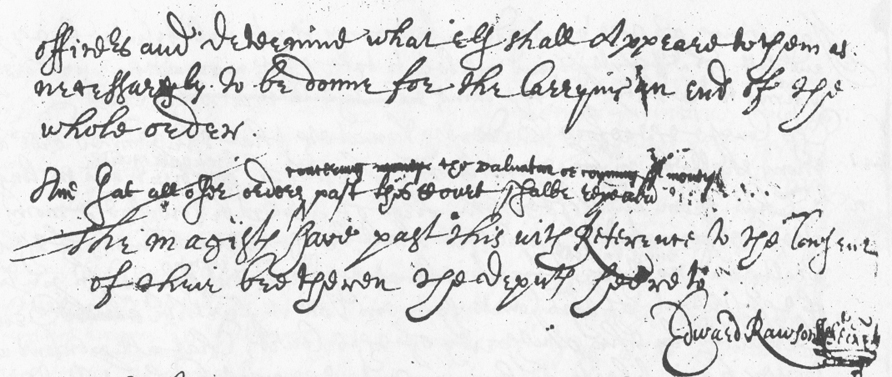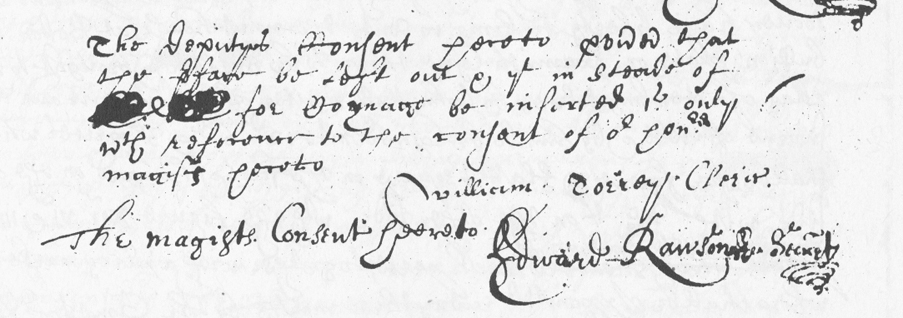Draft of the 1652 Massachusetts Coinage Act
The text has been broken down into sections that can be easily downloaded (at 100-200K per section) and should allow the for text and transcription to be viewable at the same time on most monitors.
Images presented are 125 ppi Grayscale scans from the facsimile foldout in the original 1875 edition of Sylvester S. Crosby, The Early Coins of America, located between the transcription on pages 34 and 35. The images are clickable to color scans at 200 ppi. These color images are somewhat clearer but take longer to load averaging 400-650K as compressed JPEG's or 1-2 Megabites without compression.
Deleted words are in brackets [ ] while revisions of the deletions and additions to the text are in bold. In this transcription the deleted text in brackets is given first, immediately followed by the revision in bold; in the original document deleted text is on the line while revisions and additions were added in an interlinear fashion.
The Draft Document and Transcription

fforasmuche as the new order about mony is not well Resented by the people
and full of difficultjes, and unlikely to take effect in regard no psons are found
willing to try & stampe the same, [the sajd Order is Repealed.]
Comments: "not well Resented" meaning, not well received. The final phrase, shown in italic, was blotted out, then at the request of the House of Deputies (see the addenda to the text) the entire preamble was deleted. Note the X through the top three lines at either end of "new" in line one and moving downward, represents the entire paragraph being striken out.

1 The Courte therefore Ordereth & enacteth that the printed order about
mony shall be in force vntill the first of [July] Seauenth month next and no longer
2 ly That from and After the first of September next the money heere
after Apointed & expressed shall be the Currant mony of this Common
wealth and no other vnless English & (except [it be at] the Receivers [chojse] concent therevnto ). In pursuance
Comments: Apparently rather than immediately rescinding the earlier order it was decided to wait until September (the British year began in March so the seventh month was September). It may have been thought that it would take July and August for the new mint to be erected and equipted. For further thoughts on this see the section on contemporary reference to the mint house in Appendix I to the Chronology.

of the Intent of this Courte heerin Bee it further [Acted] Ordered
& enacted by the Authority of this Court; That all persons what
soeuer have liberty to bring in vnto the mint howse at Boston all
bulljon plate or Spannish Cojne there to be melted & brought to the
allay of sterling Silver by John Hull master of the sajd mint and his

sworne officers, & by him to be Cojned into 12d : 6d : & 3d peeces which
shall be for forme & flatt & square on the sides & stamped on the one
side with N E & on the other side wth the figure XIId VId & IIId -
[peeces which shall bee] according to the valew of each peece, together with a privy marke -
which shall be Appointed euery three months by the Gouernor & known
only to him & the sworne officers of the mint.

3 And further the sajd master of the mint aforesjd is heereby Required
to cojne all the sajd mony of good Silver and of the Just allay of new sterling English
mony, & for valew to stampe [three] two pence in a shilling of lesser vallew
then the prsent English Cojne & the lesser peeces proportionably :
Comment: This article stated Massachusetts coinage would would be at sterling fineness. Using the troy nomenclature sterling fineness was defined as 11 oz. 2 dwt. of fine silver per troy pound, which assumed the additional 18 dwt. would be copper to produce a troy pound of sterling silver (we now define sterling as a fineness of .925). However Massachusetts silver would have a lower intrinsic value that equivalent English coins as they would be lighter than English coinage. Since 1601 an English shilling contained 92.9 grains of sterling; this weight had been renewed by the Commonwealth on July 17, 1649, hence the use of the term "new" sterling alloy. Article three originally stated a Massachusetts shilling would have three pence less value but this figure was revised in the draft to two pence less value. This passage has caused confusion in interpreting the passage. See section five in the Appendix to the the Chronological List of Documents relating to the Massachusetts Mint for a fuller discussion on this point (to get to that page click the MA Mint Chronology arrow at the bottom of this page). Later in article six the weight of a Massachusetts shilling was defined as three pennyweight, which equalled 72 grains. In practice the Massachusetts standard was 72 grains of sterling per shilling (or 6 grains per penny), that is, 22.5% or 2 pence and 2.8 farthings less in intrinsic value than a contemporary English shilling.

4: then the prsent English Cojne & the lesser peeces proportionably : And
all Such Cojne as aforesajd shall be acknowledged to be the Currant Cojne
of this Commonwealth & passe from man to man in all pajments accordingly
within this Jurisdiction only.
Comment: Article three goes to the colon near the end of the line, while article four actually begins with the word And. This article made Massachusetts silver legal tender. A later addition to the text explained the Massachusetts silver would only be legal tender in Massachusetts Bay, which, in 1652, included not only Massachusetts but also the settlements in New Hampshire and Maine.

5 And the mint master for himselfe & officers for their pajnes & lobour in
melting Refining & Coyning is Allowed by this Courte to take one shilling
[six pence] out of euery twenty shillings which he shall stampe as aforesajd
Comment: The minting fee was originally 1s6d (18d) out of every 20s minted but, as noted in the postscript to the draft, the fee was reduced by the House of Deputies to 1s (12d), so the words six pence were taken out. On June 20, 1652, within two weeks of the close of the spring 1652 session of the General Court, Hull renegotiated the minting fee with the mint committee so that it was raised to 15d per 20s coined. However the committee also agreed to a wastage fee of 1d per troy ounce of silver which brought the total fees back to the original request of 18d per 20s.

6 And It shall be in the liberty of any pson who brings into the mint howse
any bullion plate or Spannish Cojne as aforesajd to be present & see the same melted Refined
& Allajed, & then to take a receipt of the master of the mint for the -
weight of that which is good Silver allajed as afforesajd, for which the
mint master shall deliuer him the like weight in currant money. viz. Euery shilling
to weigh[ing the] three penny troj: weight & lesser peeces proportionably. deducing
Allowance for Cojnage as before exprssed: And that this Order being

of So great Concernment may not in any pticular thereof fall to the
ground Itt is further Ordered that mr Richard Bellingham mr william Hibbens, the prsent Secretary, Capt. John Leueret & mr Thomas Clarke be a Committee apointed by this Court to Appointe the mint howse
in some Convenjent place in Boston. To Give John Hull master of the
mint the oath suitable to his place. And to Approve of all other

officers and determine what els shall Appeare to them as
necessaryly to be donne for the Carrying an end of the
whole order.
& That all other orders concerning money the valuation or cojning of money past this Court shalbe repealed:
The magists have past this with Reference to the Consent
of their bretheren the Deputts heereto
Edward Rawson Secrety

The Deputyes Consent hereto pvided that
the pface to be left out & yt in steade of
[1s 6d] for Coynage be inserted 1 s only
w th reference to the consent of or honrd
magists hereto
William Torrey Cleric
The magists. Consent heereto.
Edward Rawson Secrety
| Section Contents | MA Mint Chronology |
|
For viewing tips and information on optimal computer settings click
here.
For questions or comments contact Special Collections by: |